Down To Earth (February 16-29 2024)
Urban Development in India
Context
- Recently, it was found that every sixth urban Indian lives in slums. With housing-for-all being a key national target, states across the country have taken steps to redevelop slums.

The Current State of Slums in India
- In India, nearly one in every six urban residents lives in a slum. These areas are usually highly populated and offer very limited space for residents.
- According to UN-HABITAT, a slum dwelling is characterised by a group of people under one roof lacking in one or more areas: sturdy and weather proof housing, adequate room, affordable and readily available clean drinking water, sufficient sanitation facilities, and legal protection against being forcibly removed from their homes.
The Need for Slum Redevelopment
- The 2011 census defined slums as ‘residential areas where dwellings are unfit for human habitation’.
- It estimated there were 1.37 crore households (17.4% of urban Indian households) living in slums.
- In absolute terms, the population in slums is projected to increase from 93.1 million in 2001 to 104.7 million in 2017.
- The need now is to turn to sustainable and 'ecological urbanisation’.
- The trajectory of urban development, where the focus is more on real estate development, a widening of roads, allowing large fuel-guzzling vehicles on them, in turn, squeezing the space meant for pedestrians, and redevelopment are the major reasons for increased pollution in Indian cities.
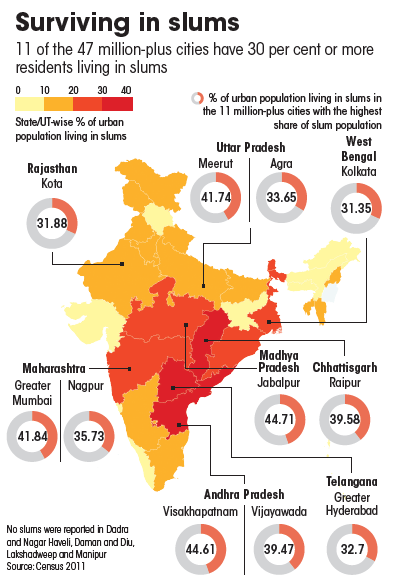
Urban Planning and Development in In
- India is experiencing a new phase of rapid urbanisation. The urban sprawl is slated to grow from 36% in 2023 to 43% in 2035, and around 60% of the nation’s population will be urban by 2050.
- However, our cities are not equipped to handle the surge in population.
- It is a complex process that requires a comprehensive approach, taking into account various factors such as population growth, infrastructure needs, environmental sustainability, and socio-economic development.
- It is high time to ensure that urban infrastructure and services keep pace with this rapid transformation.
Associated Challenges
- The Indian government passed the Slum Areas (Improvement and Clearance) Act of 1956 to improve the living conditions in slum areas.
- However, current slum policies primarily focus on housing, relocation, or in-situ development of multi-story complexes, which free up swathes of prime real estate. But in doing so, they miss out on the brewing socio-economic distress in slums.
- The recent floods in North India serve as a stark reminder to policymakers to prioritise sustainable urban planning and drainage infrastructure.
- Encroachment over the floodplains, both by people and government agencies, is a major contributing factor to the Delhi deluge. It is an indication of the lack of urban planning across all major cities.
- Nearly 65% of Indian cities are devoid of Local Area Plans, Zonal Plans, and Master Plans.
- Lack of such a plan results in unplanned city transportation, traffic, uncontrolled development, flood, poor drainage network alignment, poor monitoring, etc.
Case Studies
- Bhendi Bazaar Redevelopment Project, Mumbai: The Bhendi Bazaar redevelopment project in South Mumbai has emerged as a model for large-scale redevelopment in other cities across India and abroad.
- It has even become a prominent case study in urban renewal in several foreign universities and town planning colleges.
- Urbanization Challenges and Initiatives: This case study presents the challenges of urbanisation in India and the initiatives taken to address them.
- It discusses the strain on water supply, sanitation infrastructure, increased traffic congestion, and insufficient public transportation, demanding modernization and expansion of transportation networks.
- Urban Expansion in Medium-Sized Cities: This study aims to close the gap in research on the dynamics of cities’ spatial growth in India through a set of three exploratory case studies of medium-sized cities.
- Smart Cities Mission: The Smart Cities Mission has undertaken around 7,700 projects since its start in 2015. Under the umbrella of SAAR, the Mission, NIUA, and 15 premier institutes of the country have created 75+ case studies which have been documented into this compendium.
- Peri-Urban Ecosystems and Urban Resilience: This case study is a collective documentation of various cities pan-India and highlights the connection between the role of urban resilience and peri-urban ecosystems.
- Urban Sprawl and Its Impact: This comprehensive review explores the causes and multifaceted consequences of urban sprawl on the environment, society, and economy by examining existing literature and case studies from Indian cities.
Best Practices
- Sustainable Urban Planning: The recent floods in North India serve as a stark reminder to policymakers to prioritise sustainable urban planning and drainage infrastructure.
- Cities must have effective urban policy, governance, and use of technology in order to become growth engines.
- Corridor Densification: The Urban Development Policy of India has introduced the concept of corridor densification by Floor Space Index-linked land use control and infrastructure financing mechanism.
- This practice will catalyse more orderly and efficient spatial development toward ‘compact city’ through ‘densification’ along public transport corridors.
- Urban20 Blueprint: It represents one of the most intriguing attempts to broaden global governance beyond the strict nation-state paradigm and integrate city interests into an established structure of global cooperation.
- Ahmedabad, the Chair city for the sixth U20 Cycle, has identified six priorities that are critical for inspiring city-level actions to respond to global agendas.
- Managing Urbanisation: It provides data-based policy inputs for making India’s urbanisation manageable, economically productive, environmentally appropriate, and equitable.
- It offers advice and policy guidance to key stakeholders involved in urban planning, development, and management.
Conclusion and Way Forward
- Urban planning is an essential component of nation-building and an integral element in growth.
- As India moves rapidly along the path of accelerated development, it is crucial to reimagine how our cities are planned and developed.
- With the right policies and sustainable practices, we can ensure that our cities are equipped to handle the challenges of rapid urbanisation and become more livable for future generations.
- The India Infrastructure Report 2023 on Urban Planning and Development was recently released, covering a wide range of various complex issues related to urban planning and development.
Rising Temperatures and Labour Productivity
Context
- Recently a study found that the rising temperatures could lower labour productivity of agricultural workers by 43% by the end of the century.
About
- The world is getting warmer, and this rise in temperatures is having a profound impact on labour productivity, particularly in countries like India.
- Rising temperatures due to climate change are causing heat waves to become more frequent and intense.
- These heat waves are not just a discomfort; they are a significant hindrance to labour productivity, particularly for outdoor workers such as those in agriculture and construction.
- Heat and humidity levels rise because of climate change, and the options for moving outdoor labour to cooler hours will dramatically shrink, leading to significant worldwide labour losses.
The Situation in India
- India is one of the countries most affected by this trend, and showed the largest heat exposure impacts on heavy labour among South Asian countries, with more than 101 billion hours lost a year.
- Indian farmers are already working 23% less than their capacity during the growing season, with productivity falling by nearly half its level during the 90 hottest days of the year.
- It is despite its modest average per-capita labour losses.
- The World Bank report titled ‘Climate Investment Opportunities in India’s Cooling Sector’ warned that up to 75% of India’s workforce, or 380 million people, depend on heat-exposed labour, at times working in potentially life-threatening temperatures.
- By 2030, India may account for 34 million of the projected 80 million global job losses from heat stress associated productivity decline.
The Economic Stakes
- It is projected that economic losses associated with this lost productivity could reach up to $1.6 trillion annually if warming exceeds an additional 2 degrees Celsius relative to the present.
- According to the International Labour Organization (ILO), there would be a loss of 80 million full-time jobs, and $2,400 billion to the global GDP by 2030 due to rising temperatures resulting from climate change.
- In India, lost labour from rising heat and humidity could put up to 4.5% of India’s GDP –approximately USD 150-250 billion – at risk by the end of this decade.
Conclusion
- The rising temperatures and their impact on labour productivity is a pressing issue that needs immediate attention. It is crucial to develop and implement strategies to mitigate the effects of rising temperatures on labour productivity.
- It could include improving access to cooling solutions, shifting work hours to cooler parts of the day, and investing in heat-resistant infrastructure and technology.
- As the world continues to warm, these measures will become increasingly important to protect workers and maintain economic productivity.
Cancer in India
Context
- India saw the world’s third highest number of new cancer cases and the second highest mortality rate attributed to the disease in 2022. The country’s cancer burden is projected to almost double by 2050.
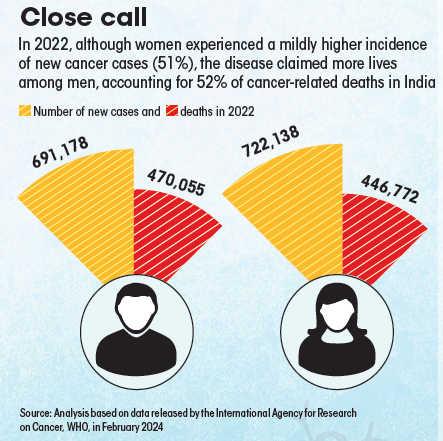
About
- Cancer, a group of diseases characterised by the uncontrolled growth and spread of abnormal cells, is a major public health concern in India.
- The burden of cancer in the country has been steadily increasing over the years, posing significant challenges to the healthcare system.
Current Scenario
- According to a report by the Indian Council of Medical Research (ICMR) and National Centre for Disease Informatics & Research (NCDIR), the number of cancer cases in India in 2020 was estimated to be 13.9 lakh.
The report also projected that the cancer burden in India could increase to 15.7 lakh by 2025
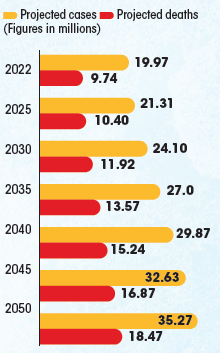
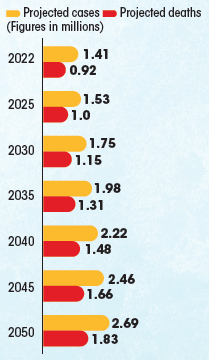
- Cancer cases in India increased at an average annual rate of 1.1-2% from 2010-2019, and deaths from cancer in the country also went up at an average rate of 0.1-1% in the same period.
- In 2022, the projected number of new cancer cases in India was 1,461,427, with a crude incidence rate of 100.4 per 100,000 individuals.
- By 2050, it is projected that global cancer cases will surge by 77%, accompanied by a 90% increase in cancer-related deaths.
- India is poised to witness a dramatic rise in cancer cases, with a projected surge of 90%, coupled with a staggering 100% increase in cancer related deaths. This rate of increase surpasses the global projections.
Major Types of Cancer
- In men, the most common cancers are of the lung, oral cavity, stomach, and oesophagus, while in women, breast, cervix, ovary, and gallbladder cancers are the most common.
- Leukaemias were the most prominent type of cancer observed across the 0-19-year age group.
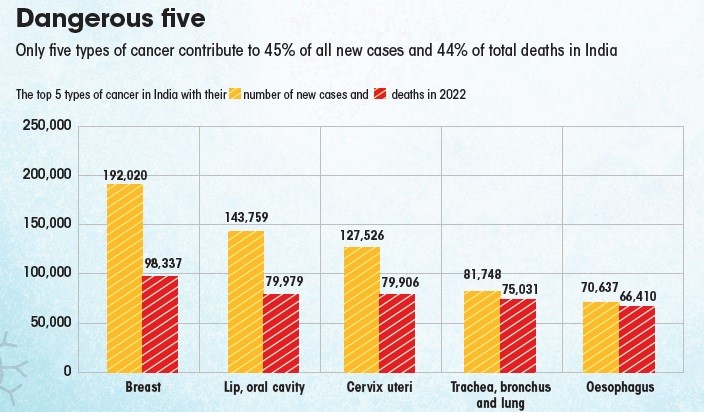
Risk Factors
- Tobacco use (in all forms) is a major avoidable risk factor for the development of cancer in 27% of cancer cases.
- Other important risk factors include alcohol use, inappropriate diet, low physical activity, obesity, and pollution.
Related Government Initiatives
- National Cancer Control Programme: India is one of the few developing countries that has formulated a National Cancer Control Programme.
- It envisages control of tobacco-related cancers, early diagnosis and treatment of uterine cervical cancer, and distribution of therapy services, pain relief, and palliative care through augmentation of health infrastructure.
- Ayushman Bharat: Under the Ayushman Bharat Health and Wellness Centres (AB-HWCs) scheme, screening for three common cancers i.e., oral, breast, and cervical, along with other common Non-Communicable Diseases, is an integral part of service delivery.
- Treatment of cancer under the Pradhan Mantri Jan Arogya Yojana has been one of the prime focus areas to safeguard the beneficiaries from catastrophic expenditure of cancer treatment.
- Focus on Oncology in AIIMS: Significant focus on Oncology in its various aspects has been ensured in the new AIIMS that are being established under the aegis of Pradhan Mantri Swasthya Suraksha Yojana (PMSSY).
- Strengthening Cancer Care Infrastructure: Cancer Care Facilities in other Medical Colleges under PMSSY have been created/planned.
- India-UK Research Collaboration: In order to promote research in affordable approaches to cancer, the government’s Department of Biotechnology has joined hands with British charity, Cancer Research UK, to launch a research challenge for affordable approaches to cancer.
The Way Forward
- Reducing cancer is a prerequisite for addressing social and economic inequity, stimulating economic growth, and accelerating sustainable development.
- We need to focus on three key aspects: risk reduction, early detection, and programmatic and policy solutions.
- Community empowerment through a multisectoral approach that brings together government, private practitioners, and civil society to increase health literacy and promote certain behaviour can go a long way in reducing potential risk factors.
- Improved awareness can also prevent stigma attached to the disease.
Multidimensional Poverty
Context
- The term ‘Multidimensional Poverty’ appeared in the Union Budget (2024-25) for the first time.
About the Multidimensional Poverty
- It is a concept that goes beyond traditional income-based poverty measures to consider multiple deprivations that individuals or households face in their daily lives.
- The Multidimensional Poverty Index (MPI) is a measure that takes into account the multiple aspects of poverty.
- It considers 10-12 indicators that include health, education, and standard of living to determine if a household and people living in it are deprived of the facilities.
- The National MPI by NITI Aayog uses the internationally acclaimed Alkire Foster methodology.
The Current State of MPI
- India has seen a significant decline in multidimensional poverty over the years.
- According to the National MPI, India has registered a significant decline of 9.89 percentage points in the number of India’s multidimensionally poor from 24.85% in 2015-16 to 14.96% in 2019-2021.
- The rural areas witnessed the fastest decline in poverty from 32.59% to 19.28%.
Challenges in Addressing Multidimensional Poverty
- Despite the progress, India still has a significant number of people living in multidimensional poverty.
- In 2005-06, about 645 million people were in multidimensional poverty in India, with this number declining to about 370 million in 2015-16 and 230 million in 2020-21.
Related Initiatives
- National Multidimensional Poverty Index (MPI): The National MPI by NITI Aayog uses the internationally acclaimed Alkire Foster methodology.
- This analysis attempts to study the decline in poverty rates and the number of multidimensionally poor people across various time periods.
- Saubhagya: It is also known as Pradhan Mantri Sahaj Bijli Har Ghar Yojana, aims to provide energy access to all by last mile connectivity and electricity connections to all remaining un-electrified households in rural as well as urban areas.
- Pradhan Mantri Awas Yojana (PMAY): It seems to be a milestone scheme to the urban poor with a target of building 20 million affordable houses.
- Pradhan Mantri Jan Dhan Yojana (PMJDY): It is a National Mission for Financial Inclusion to ensure access to financial services, namely, banking/ savings & deposit accounts, remittance, credit, insurance, and pension in an affordable manner.
- Samagra Shiksha: Samagra Shiksha is an overarching programme for the school education sector extending from pre-school to class 12.
- It aims to ensure inclusive and equitable quality education at all levels of school education.
- Poshan Abhiyan: It is known as the National Nutrition Mission, is a flagship programme of the Ministry of Women and Child Development.
- It aims to improve nutritional outcomes for children, pregnant women, and lactating mothers.
- Anaemia Mukt Bharat: Anaemia Mukt Bharat is an initiative to reduce the prevalence of anaemia in India.
- Pradhan Mantri Ujjwala Yojana: It aims to provide LPG connections to families below the poverty line.
The Way Forward and Conclusion
- The National MPI measures simultaneous deprivations across the three equally weighted dimensions of health, education, and standard of living that are represented by 12 SDG-aligned indicators.
- These include nutrition, child and adolescent mortality, maternal health, years of schooling, school attendance, cooking fuel, sanitation, drinking water, electricity, housing, assets, and bank accounts.
- Addressing multidimensional poverty is crucial for achieving sustainable development. With the right policies and sustainable practices, we can ensure that our society is equipped to handle the challenges of this growing concern and provide a better quality of life for all.
Agromet Services
Context
- Recently, the India Meteorological Department (IMD) has decided to discontinue the agromet units services.
About
Services:
- These are a crucial part of India’s agricultural sector, which are operated by the IMD under the Ministry of Earth Sciences (MoES), these services provide weather forecasts and agrometeorological advisories to farmers at the district and block levels.
Objectives
- To minimise the impact of adverse weather on crops and to make use of favourable weather to boost agricultural production.
- These services provide crucial district and block level agrometeorological advisory service to lakhs of farmers across the country.
- They combine IMD’s weather forecast and validate it with local weather variability and conditions, specifically for the farming community.
The Structure of Agromet Services
- Agromet Services are provided through Agromet Field Units (AMFUs) located at State Agricultural Universities (SAUs), institutes of Indian Council of Agricultural Research (ICAR), and Indian Institute of Technology (IIT) etc., and District Agromet Units (DAMUs) at Krishi Vigyan Kendras (KVKs) under ICAR network.
- DAMUs, on the other hand, provide block-level agromet advisories.
- AMFUs provide advisories at the zonal level, each catering to four to five districts.
The Impact
- Agromet advisories have played a significant role in helping farmers make informed decisions about their agricultural operations.
- These advisories have helped increase farmers’ resilience against worsening weather and climate impacts, consequently reducing their losses and the claim amount under the Pradhan Mantri Fasal Bima Yojana.
Associated Issues
- Discontinuation of District Agromet Units (DAMUs): As of March 2024, the government has decided to wind up the operations of 199 District Agromet Units (DAMUs), beyond the current financial year (2023-2024).
- This decision has been met with concern from scientists and farmers alike, who fear that the discontinuation of these services could lead to significant losses for farmers.
- Financial and Administrative Issues: An advisor of NITI Aayog had advised reevaluation of the ‘necessity of providing staff at each DAMU’.
- The MoES needs to have ‘centralised units instead of field units as the collection of data is automated’.
Conclusion
- Agromet Services play a vital role in India’s agricultural sector, providing farmers with crucial weather forecasts and agrometeorological advisories.
- While recent developments have raised concerns about the future of these services, their importance in supporting India’s farmers and boosting agricultural production cannot be overstated.
Forever Chemicals (PFAS)
Context
- Recently, the EU and New Zealand provisionally agreed on a proposal to remove micropollutants from urban wastewater, particularly those coming from toxic cosmetics and pharmaceuticals.
About the Forever Chemicals (Per- and Polyfluoroalkyl Substances)
- These are a group of man-made chemicals that have been in use since the 1940s.
- They are used in a wide range of consumer products, from non-stick pans and waterproof clothing to makeup and fire fighting foams.
- However, these chemicals pose a significant threat to human health and the environment due to their persistence and toxicity.
- PFAS are called ‘forever chemicals’ because they do not naturally break down and can persist in the environment for decades.
- They are made up of chains of carbon and fluorine atoms held together by some of the strongest chemical bonds in nature.
- It makes them highly resistant to heat, water, and oil, properties that have made them popular in a wide range of applications.
The Health Risks
- Chronic exposure to PFAS has been linked to a host of health issues, including cancer, liver damage, thyroid disease, and reduced immune responses.
- They have also been associated with low birth weights and several kinds of cancer.
- PFAS are pervasive in the environment and have been detected in soil, dust, and drinking water around the world.
- Studies suggest they’re in 98% of Americans’ bodies.
The Environmental Impact
- PFAS have been found in rainwater and snow in even the most remote locations on our planet.
- They can accumulate in plants and animals as they move through the food chain, so they may end up in the foods we eat including milk and eggs.
- For instance, research from 2014 and 2019 showed traces of PFAS were still present in most rivers, lakes and groundwater in the UK.
Efforts to Destroy Forever Chemicals
- Scientists are working on methods to capture these synthetic chemicals and destroy them, but it isn’t simple.
- The latest breakthrough, published in the journal Science, shows how one class of PFAS can be broken down into mostly harmless components using sodium hydroxide, or lye, an inexpensive compound used in soap.
- It isn’t an immediate solution to this vast problem, but it offers new insight.
Coral Reef
Context
- Recently, the Coral Reef Watch Programme of USA, the world’s main system for warning about heat stress on coral reefs, has added three new alert categories to represent ever increasing temperature extremes.
About the Coral Reef Watch
- Coral Reef Watch (CRW) is a program established by the National Oceanic and Atmospheric Administration (NOAA) in 2000.
- For over two decades, NOAA CRW has been utilising remote sensing, modelled, and in-situ data to predict, observe, and alert users globally to threats to the coral reef environment.
Roles
- NOAA’s Coral Reef Watch is a free online tool that provides a global analysis of sea surface temperature (SST) and outlooks to identify coral reefs that are at risk of bleaching.
- It’s clear that remotely monitoring coral reefs and providing actionable intelligence are critical for early detection, on-the-ground response, communication, and enhancing coral reef resilience in a rapidly warming world.
The Importance of Coral Reefs
- Coral reefs are one of Earth’s most diverse ecosystems.
- They provide significant ecological, economic, and societal benefits valued globally at about USD$9.8 trillion each year.
- Unfortunately, reefs worldwide are threatened by an increasing array of impacts, primarily from global climate change, unsustainable fishing practices, and land-based pollution.
Coral Reefs
- A coral reef is an underwater ecosystem characterised by reef-building corals. Reefs are formed of colonies of coral polyps held together by calcium carbonate.
- Corals share a symbiotic relationship with single-celled algae called zooxanthellae. The zooxanthellae also give corals their bright colour.
- The algae provides the coral with food and nutrients, which they make through photosynthesis, using the sun’s light. Algae provides up to 90% of the coral’s energy.
- In turn, the corals give the algae a home and key nutrients.
- They provide habitat for sharks, swordfish, sea stars, octopus, shrimp and many other kinds of fish.
Conditions favourable to Corals
- Temperature: The temperature of the water should not be below 20°C. The most favourable temperature for the growth of the coral reefs is between 23°C to 25°C.
- The temperature should not exceed 35°C.
- Salinity: Corals can survive only under saline conditions with an average salinity between 27% to 40%.
- Shallow Water: Coral reefs grow better in shallow water having a depth less than 50 m. The depth of the water should not exceed 200m.
The Threat of Coral Bleaching
- First observed in the early 1980s, mass coral bleaching has become one of the most visible and damaging marine ecological impacts of persistently rising ocean temperatures.
- Bleaching is the process by which corals lose the symbiotic algae (zooxanthellae) that give them their distinctive colours and main energy sources.
- If a coral is severely bleached, disease and death become likely.
Do you know how the warnings are calculated?
- The warning system uses a unit called Degree Heating Week (DHW) that measures the amount of accumulated heat stress corals face at any given time.
- For example, 1 DHW is accumulated if corals are subjected to temperature 1oC above the usual maximum for seven days.
- Coral Reef Watch’s old system gave the highest rating at 8 DHWs or above, but during the 2023 summers, coral reefs in the northern hemisphere were exposed to heat stress as high as 20 DHWs.
Recent Developments
- In January 2024, NOAA CRW released the Version 3.5 Thermal History product suite, spanning 1985-2023.
- In December 2023, NOAA CRW’s Bleaching Alert Area product was updated to feature Bleaching Alert Levels 1-5.
- The three new categories are added:
- Level 3: risk of multi-species mortality;
- Level 4: risk of severe, multi-species mortality;
- Level 5: risk of near complete mortality of more than 80% of corals.
- These new Alert Levels provide important, added detail, for when extreme marine heat stress exceeds Alert Level 2 conditions.
Conclusion
- The Coral Reef Watch program plays a crucial role in the global effort to conserve and protect our coral reefs.
- By providing accurate and timely information about the health of these vital ecosystems, Coral Reef Watch helps scientists, policymakers, and local communities take action to mitigate the impacts of climate change and other threats to coral reefs.
Groundwater Decline in Aquifers
Context
- Recently, Nature, in its first global aquifer study, has found that groundwater levels in half of the 1,693 aquifers across 40 countries have fallen since 2000.
About
- Groundwater, an invisible yet crucial resource, is facing a global crisis.
- The overuse and pollution of this resource have led to a rapid and widespread decline in groundwater levels.
The Current State of Groundwater
- Groundwater is a vital resource for water and food security as it acts as a climate buffer, sustaining communities and ecosystems vulnerable to changes in water availability due to climate change.
- However, human activities, both indirectly through changes in rainfall driven by anthropogenic climate change and directly through overuse, are affecting its availability.
- In India, groundwater plays a significant role in meeting the water demand. The country accounts for about 2.45% of the world’s surface area, 4% of the world’s water resources, and about 16% of the world’s population.
- Despite this, the total utilisable water resource in the country is only 1,122 cubic km.
Groundwater Decline in India
- The average rate of groundwater decline in parts of India has been 2.6 cm per year in this century.
- The decline is particularly sharp around Delhi, Western Uttar Pradesh, Haryana, and Rajasthan.
- Over-extraction in some states like Rajasthan and Maharashtra has led to an increase in fluoride concentration in groundwater.
- Out of 6607 groundwater assessment units in India, 1071 units are over-exploited, and 914 units are critical.
- These units have a withdrawal of groundwater more than the recharge, leading to a decline in groundwater levels.
The Impact of Groundwater Decline
- The decline in groundwater levels has severe implications.
- It affects the availability of drinking water, irrigation for agriculture, and industrial uses.
- In drought-prone areas of Rajasthan, Gujarat, Maharashtra, and Tamil Nadu, the overuse of groundwater resources has led to a decline in the groundwater table.
- Moreover, the decline in groundwater levels can lead to other environmental issues such as land subsidence and saline water intrusion.
- It also poses a threat to the sustainability of wells and yields of aquifers.
Conclusion
- The current state of groundwater decline is a matter of grave concern.
- Groundwater-level declines have slowed in 20% of aquifer systems, reversed in 16%, and levels have risen continuously in 13%.
- These represent almost half of the aquifer systems studied.
- Efforts are needed to manage and conserve this precious resource.
- Measures such as water harvesting, efficient use of water, and artificial recharge of groundwater can play a significant role in addressing this issue.
- It’s high time to realise the importance of groundwater and take steps to ensure its sustainability for future generations.
Biodiversity Crisis and Global Reporting Initiative
Context
- Recently, the Global Reporting Initiative (GRI) released a revised transparency standard to report a global response to the biodiversity crisis.
About
- The biodiversity crisis is a pressing issue that has been gaining global attention. The rapid loss of biodiversity, driven by human activities, is leading to drastic changes in ecosystems and the services they provide.
- In response to this crisis, the Global Reporting Initiative (GRI) has developed a new Biodiversity Standard.
The Biodiversity Crisis
- Biodiversity, the variety of life on Earth, is declining at an unprecedented rate. Over one million plant and animal species are being pushed towards extinction.
- This loss of biodiversity is largely driven by human activities, including land use changes, pollution, invasive species, and climate change.
The Global Reporting Initiative (GRI)
- The GRI is an international independent standards organisation that assists businesses, governments, and other entities to understand and report their impacts on issues related to climate change, human rights, and corruption.
- The GRI has developed a new Biodiversity Standard to address the biodiversity crisis.
The New GRI Biodiversity Standard
- The new GRI Biodiversity Standard demands reporting of drivers of biodiversity loss and their impact on Indigenous Peoples.
- The standard aims to understand the impacts of supply chain and operations as nature faces extreme pressures.
- The ‘GRI 101: Biodiversity 2024’ is a major update to the Biodiversity Standard that can be used by companies across the world.
- The document will be formally implemented for reporting from January 1, 2026, onward.
- The new standards are aimed at enabling companies to meet the growing demands sought by multiple stakeholders for information on biodiversity impacts.
- The GRI Biodiversity Standard offers complete transparency throughout the supply chain, a crucial aspect where often the major biodiversity impacts can go unreported.
Conclusion
- The biodiversity crisis is a complex issue that requires a multi-faceted approach.
- The new GRI Biodiversity Standard is a significant step towards addressing this crisis.
- By demanding transparency and accountability from organisations, it encourages them to take responsibility for their impacts on biodiversity.
- As we move forward, such initiatives will play a crucial role in conserving our planet’s biodiversity.
Snow Leopard Population Assessment
Context

- Recently, the Wildlife Institute of India, in its first-ever ‘Snow Leopard Population Assessment’ highlighted that the country has 718 snow leopards across states.
Snow Leopard Population Assessment in India (SPAI)
- Snow leopards, the elusive and majestic creatures of the high mountains, are a species of great interest to conservationists worldwide.
- SPAI is a significant initiative undertaken to understand the status of this vulnerable species in the country.
Snow Leopard
- It is often referred to as the ‘ghost of the mountains’, is a magnificent big cat that roams the steep mountains of Central Asia.
- It is globally recognized as a symbol of high-mountain ecosystems.
Threats
- The snow leopard faces several threats, including habitat loss, poaching, and the impacts of climate change.
- Due to unsustainable hunting practices, it is losing its main prey – ungulates, such as the Siberian Ibex or Argali.
- The human-wildlife conflict is also intensifying.
Conservation Efforts
- The IUCN Save Our Species program has launched SOS Central Asia to support the Central Asian Mammals Initiative (CAMI) created by the Convention on Migratory Species (CMS).
- It supports snow leopard conservation efforts, including community-focused conservation programs in Pakistan’s Gilgit-Baltistan Province.
- Red List Category (IUCN): Vulnerable
SPAI
- It is the first-ever scientific exercise that reports the snow leopard population in India. Conducted over four years (2019-2023), the SPAI systematically covered over 70% of the potential snow leopard range in the country.
- The Wildlife Institute of India (WII) is the national coordinator for this exercise.
Methodology
- The SPAI exercise was conducted using a meticulous two-step framework.
- The first step involved evaluating snow leopard spatial distribution, incorporating habitat covariates into the analysis.
- In the second step, snow leopard abundance was estimated using camera traps in each identified stratified region.
- Camera traps were deployed at 1,971 locations for 180,000 trap nights.
Findings
- The assessment revealed that there are 718 snow leopards in India.
- A total of 241 unique snow leopards were photographed.
- The highest number of snow leopards are in Ladakh (477), followed by Uttarakhand (124), Himachal Pradesh (51), Arunachal Pradesh (36), Sikkim (21), and Jammu and Kashmir (9).
Implications
- The report emphasised the need for a dedicated Snow Leopard Cell at the Dehradun-based WII under the Union Ministry of Environment, Forest, and Climate Change (MoEF&CC).
- Its objective should be long-term population monitoring, organised studies, and consistent field surveys.
Conclusion
- The SPAI has significantly increased our understanding of the snow leopard population in India.
- This knowledge is crucial for formulating effective conservation strategies and ensuring the survival of this magnificent species in the wild.
Mumps, A Viral Disease
Context
- Recently, Kerala and Himachal Pradesh reported an outbreak of mumps, a viral disease.
About the Mumps
- It is an acute infectious disease that primarily affects children and young adults.
- It is caused by a paramyxovirus, of which there is only a single serotype.
- Humans are the only known host for the mumps virus, which spreads via direct contact or airborne droplets from the upper respiratory tract of infected individuals.
- It typically starts with a few days of fever, headache, muscle aches, tiredness, and loss of appetite.
- The most distinctive symptom of the disease is the swelling of the salivary glands, often referred to as parotitis.
Impacts
- While mumps is frequently reported in children aged 5-9 years of age, adolescents and adults can also be affected.
- In most cases, mumps is a self-limiting disease and disappears without sequelae.
- However, complications may occur such as encephalitis or sensorineural deafness.
- Orchitis, a painful inflammation of the testes, occurs in 20% of young adult males who develop mumps.
- Prevention and Vaccination:
- Safe and effective vaccines against mumps have been available since the 1960s.
- The vaccine is most often incorporated into national immunisation programmes in a combined measles-mumps-rubella (MMR) vaccine.
- In countries where large-scale immunisation against mumps has been implemented, the incidence of the disease has dropped dramatically.
Targeted Public Distribution System (Control) Amendment Order
Context
- Recently, the Union Ministry of Consumer Affairs, Food and Public Distribution introduced the Targeted Public Distribution System (Control) Amendment Order.
About the Targeted Public Distribution System
- It is a system for distributing subsidised food and non-food items to India’s poor.
- It provides for coverage of up to 75% of the rural population and up to 50% of the urban population for receiving subsidised food grains under TPDS.
- It covers about two-thirds of the population.
The TPDS (Control) Amendment Order
- It aims to strengthen the system and ensure that it reaches the most vulnerable sections of society.
- The amendment order was issued as part of the Essential Commodities Act, 1955.
- It mandates that the states regularly report cancellation of ration cards or issuance of new ones, to help the Union government to update the Central repository.
Impact of the Amendment Order
- The amendment order has the potential to significantly improve the effectiveness of the TPDS.
- It can help strengthen the public distribution system (PDS) by allowing states to distribute their produce to locals.
- It allows people to buy food grains according to their preferences.
- However, despite these potential benefits, there are challenges in implementing the amendment order.
- For instance, only 23 states have implemented the Decentralised Procurement Scheme (DCP) so far.
- Under the scheme, food grains are procured and distributed by state governments.
Wild Life (Protection) Licensing (Additional Matters for Consideration) Rules, 2024
Context
- Recently, the Union Ministry of Environment, Forest and Climate Change (MoEF&CC) issued the Wild Life (Protection) Licensing (Additional Matters for Consideration) Rules, 2024.
About
- It is a significant amendment to the wildlife trade rules in India, marking the first revision since 1983.
- The revised rules have brought about some notable changes in the process of issuing licences for wildlife trade.
Key Changes
- The central government has offered fresh guidelines for granting licences to stakeholders involved in snake venom, captive animals, trophy animals, and stuffed animals.
- The rules from 1983 prohibited issuing licences to trade in a wild animal categorised under Schedule I or Part II of Schedule II under the Wildlife Protection Act 1972.
- Licences were granted in exceptional cases with previous approval of the central government.
- However, the new guidelines state that, ‘No such licences shall be granted if it relates to any wild animals specified in the Schedule I to the Act, except with previous consultation of the central government’.
Additional Matters for Consideration
- The authorised officers must consider the capacity of the applicant to handle the business concerned in terms of facilities, equipment, and feasibility of premises for the business.
- The official has to note the source and manner in which the supplies would be obtained by the business involved, including the number of licences already issued in the concerned area.
- It further seeks considering the implications on hunting or trade of wild animals concerned in case of granting of the licence.
Implications
- The notification, however, does not clarify why the restrictions on Schedule II species have been lifted.
- Earlier in 2022, the central government in amendment of the Wildlife Protection Act merged four schedules of wild animals into two, reducing the six schedules to four.
- As per the revised amendments, Schedule I includes animals requiring utmost protection while Schedule II has species needing comparatively lower protection.
- Plant species have been listed under Schedule II while Schedule IV is dedicated to species to be protected under the Convention on International Trade in Endangered Species of Wild Fauna and Flora (CITES).
Mineral Conservation and Development (Amendment) Rules, 2024
Context
- Recently, the Union Ministry of Mines has introduced the Mineral Conservation and Development (Amendment) Rules, 2024, to enhance regulatory measures governing reconnaissance, prospecting, exploration, reporting obligations and penalties in the mining sector.
About
- The revised rules have brought about some notable changes in the process of mineral conservation and development.
- The central government has offered fresh guidelines for the conservation and systematic development of minerals.
- It is a significant amendment to the mining regulations in India.
- It marks a crucial revision in the process of mineral conservation and development.
Key Changes
- The rules from 2017 prohibited certain activities without holding an operating right as required under sub-section (1) of section 5.
- However, the new guidelines state that, ‘No such licences shall be granted if it relates to any wild animals specified in the Schedule I to the Act, except with previous consultation of the central government’.
Matters for Consideration
- In additional matters to consider granting of licences, the authorised officers must consider the capacity of the applicant to handle the business concerned in terms of facilities, equipment, and feasibility of premises for the business.
- The official has to note the source and manner in which the supplies would be obtained by the business involved, including the number of licences already issued in the concerned area.
- It further seeks considering the implications on hunting or trade of wild animals concerned in case of granting of the licence.
The Economics of the Food System Transformation
Context
- Recently, the Food System Economics Commission released the global policy report on the Economics of the Food System Transformation.
About
- It is a comprehensive study that provides a roadmap for transforming our current food systems into more sustainable, inclusive, and health-enhancing systems.
Key Findings
- The report identifies the elements required for a complete transformation to an inclusive, health-enhancing, and environmentally sustainable global food system.
- It shows that such a transformation is not only biophysically and technically feasible but also offers immense economic benefits to societies across the world.
Economic Benefits
- The socio-economic benefits of transforming food systems around the world are estimated to be between $5 trillion and $10 trillion annually, equivalent to between 4 and 8% of global GDP in 2020.
- $500 billion in annual investment could lead to a transformation of the world's food systems to be inclusive, health-enhancing and environmentally sustainable.
- It is just 0.2-0.4% of global GDP.
- These benefits are realised through improved health outcomes, reduced environmental degradation, and increased economic productivity.
Urgency and Feasibility
- The report emphasises that a transformation of food systems is urgently needed, possible, and offers enormous economic benefits.
- Our food systems — the way we produce, market, and consume food — are part of the political, social, economic, ecological, and cultural fabric of our communities.
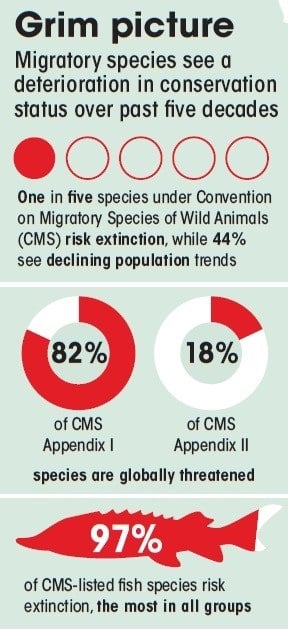
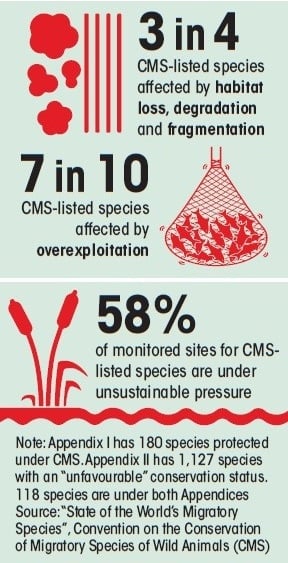
Challenges and Solutions
- The report confronts the challenges of negotiating between diverse stakeholders.
- It outlines six pathways for policymakers to accelerate urgent action to transform food systems.
- These include enhancing collaboration and inclusion at all levels, enabling a transition to healthy and sustainable diets, embracing agricultural reform and nature-positive production, increasing action against food loss and waste, transforming financial mechanisms to support sustainable food systems, and championing consistent, accurate monitoring and reporting.
State of the World's Migratory Species
Context
- Recently, the first-ever report on the ‘State of the World’s Migratory Species’ was launched by the Convention on the Conservation of Migratory Species (CMS) of Wild Animals, a treaty to conserve migratory species under the UN Environment Programme (UNEP), at COP 14.
About the State of the World’s Migratory Species
- It presents a critical and comprehensive assessment of the conservation status and population trends of migratory species globally.
Key Findings
- It reveals alarming statistics: nearly half (44%) of the migratory species are in decline, with a significant number threatened with extinction.
- More than one-in-five (22%) of CMS-listed species are threatened with extinction.
- Nearly all (97%) of CMS-listed fish are threatened with extinction.
- The extinction risk is growing for migratory species globally, including those not listed under CMS.
Threats to Migratory Species
- The two greatest threats to both CMS-listed and all migratory species are overexploitation and habitat loss due to human activity.
- Three out of four CMS-listed species are impacted by habitat loss, degradation, and fragmentation, and seven out of ten CMS-listed species are impacted by overexploitation (including intentional taking as well as incidental capture).
- Climate change, pollution, and invasive species are also having profound impacts on migratory species.
Conservation Efforts

- The report highlights the urgent need for global conservation efforts, emphasising the role of migratory species in maintaining ecosystem balance and advocating for the protection of key biodiversity areas.
- Nearly half (~ 51%) of Key Biodiversity Areas identified as important for CMS-listed migratory animals do not have protected status, and 58% of the monitored sites recognized as being important for CMS-listed species are experiencing unsustainable levels of human-caused pressure.
- The assessment draws extinction risks and abundance trends from data with the International Union for Conservation of Nature (IUCN)’s Red List and the Living Planet Index (managed by the Zoological Society of London and the World Wide Fund for Nature or WWF).
- Over two thirds (70%) of the CMS-listed reptiles and nearly all (97%) of the cms-listed fish are threatened with extinction.
- In contrast, the outlook for birds and mammals appears more favourable overall, with more than three quarters (78%) of the birds and almost half of the cms-listed mammals (44%) — terrestrial (43%) and aquatic (45%) — categorised as Least Concern.
Grand Ethiopian Renaissance Dam (GERD)
Context
- Recently, it was found that Ethiopia's debt default is intricately linked to its efforts in building climate-resilient infrastructure, such as the Grand Ethiopian Renaissance dam.
About the GERD
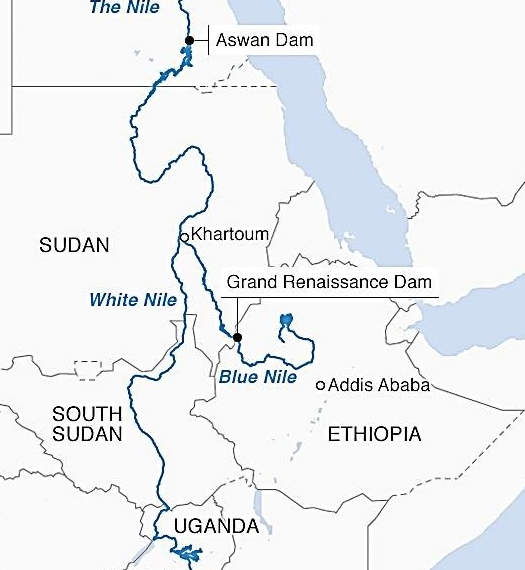
- It is set to become Africa’s largest hydroelectric power plant, formerly known as the Millennium Dam, is a gravity dam on the Blue Nile River in Ethiopia that has been under construction since 2011.
- Significance:
- The GERD is at the heart of Ethiopia’s ambition to become Africa’s biggest power exporter.
- With a storage capacity of 74 billion cubic metres of water, the dam is expected to produce more than 15,000 gigawatt-hours of electricity, beginning in 2022.
- This project is seen as a symbol of Ethiopia’s sovereignty and is being financed solely by Ethiopia.
The Controversy
- The dam has been a source of tension among Ethiopia, Egypt, and Sudan. Egypt, which relies on the Nile for 90% of its freshwater supply, fears that the rapid filling of the reservoir in upstream Ethiopia could cause a drastic reduction in its water supplies.
- Sudan, on the other hand, hopes to gain access to cheap electricity from the dam, which would provide a welcome boost for its troubled economy.
- The current dispute over the GERD is directly linked to colonial-era Nile treaties that allocated the entire flow of the Nile between Egypt and Sudan, without considering the interests of upstream states.
- Ethiopia was left with no option but to start constructing the GERD by itself, becoming the third African country in as many years to default on its global debt payment.
Kankrej Cattle
Context
- Recently, it was found that the indigenous Kankrej cattle which are employed as draught cattle and used for milk production are facing pressure over the past years due to lack of adequate welfare programmes and policies and poor availability of fodder.

About
- The Kankrej cattle, a breed of Zebuine cattle, is one of the oldest and most revered cattle breeds in India.
- Originating from the arid region of the Rann of Kutch in Gujarat and neighbouring Rajasthan, the Kankrej cattle have a rich history dating back over 1000 years.
- It is believed to have descended from the Auroch, a wild ox that roamed India thousands of years ago.
- They are large in size and are one of the heaviest Indian cattle breeds.
Utility and Adaptability
- The Kankrej cattle are a dual-purpose breed, used both for drought work and for milk production.
- They are adapted to the geo-climatic conditions of Saurashtra and Kachchh, have immense drought power, are resilient to stress conditions, and are known for yielding a good quantity of milk and good fat content even in stress conditions.
- They are often raised under drought conditions and have become extremely popular in hot climates like those of Brazil, where they are known as Guzerat Cattle.
- These cattle are resistant to external parasites and heat.
Conservation Efforts
- The Central Herd Registration Scheme (CHRS) under the Department of Animal Husbandry & Dairying, Government of India, has included Kankrej cattle among the indigenous breeds covered for conservation and improvement.
- The Livestock Research Station in Gujarat is the designated Germplasm unit for Kankrej cattle.
Question For Practice
- Discuss the challenges and opportunities in slum development in India. How can sustainable practices be incorporated into current development strategies to improve living conditions and infrastructure in these areas?
- Discuss the role of lifestyle, genetics, and environmental factors in cancer prevalence. How can India’s healthcare system adapt to manage this burden effectively?
- Examine the concept of multidimensional poverty in India. How does it differ from income poverty? Discuss the impact of multidimensional poverty on various social and economic aspects of the country.
- Discuss the role and impact of Agromet Services in India. How have these services contributed to the agricultural sector, particularly in terms of crop yield and farm management?
QUICK LINKS